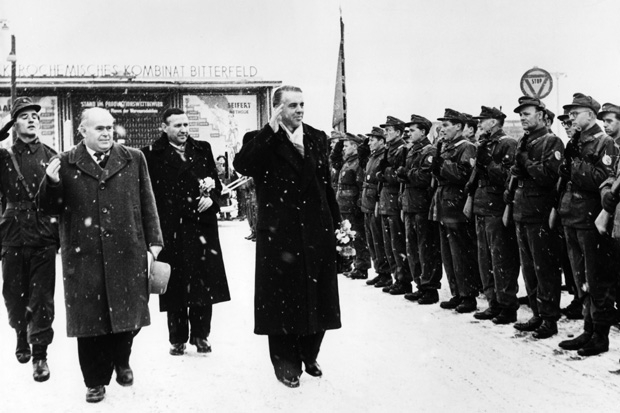Albania is a small country of 2.7 million people, wedged within the Balkan peninsula. Separated from both Greece and Italy by mere kilometres of seascape and shoreline, it borders the European Union, and, with official candidate status as a member country, strongly hopes for closer ties.
As Fred C. Abrahams describes it, the country’s transition from cultish Stalinist dictatorship to functioning democracy in only three decades should be a source of debate, intrigue and pride. The principal protagonists in the ‘drama’ of transition are ‘a paranoid dictator, an ambitious doctor, a scheming economist and an urban artist’. Observed by Abrahams himself — first as a media trainer, and next as a researcher for Human Rights Watch — the book’s action begins in the aftermath of Albania’s first democratic elections in 1990, and spans nearly three decades of complex politics leading up to Edi Rama’s new Socialist coalition, elected in 2013.
Abrahams’s first impression of Tirana — a city ‘where even the light seems old’ — follows his arrival in 1993. The country’s cruel dictator, Enver Hoxha — a failed French student, one-time language teacher and Tirana tobacconist — has been dead since 11 April 1985. An enormous, pyramid-shaped museum, designed by Hoxha’s daughter — which once displayed a neatly pressed pair of the late despot’s pyjamas — now accommodates a pro-democracy radio station. To Abrahams’s surprise, the late dictator’s villa houses ‘a fast food restaurant with golden arches called McMarriott’.
Hoxha, who was both ‘a cultured man, who studied in France, wore dapper suits, knew history and enjoyed literature’ and ‘a paranoid and brutal dictator’, has left an indelible mark on the city. Depicting himself as benevolent ‘Uncle Enver’, Hoxha forced the people of Albania to endure his 44-year tenure as General Secretary of the Albanian Communist Party. At various stages in his reign he adulated the work of comedy actor Norman Wisdom, sunk British battleships with mines, and purged the ranks of the Party of Labour in pursuit of his opponents. When the rigid framework of rules disappeared, Albania was ‘transformed from a country with sealed borders to a smugglers’ dream, from the world’s only officially atheist state to a playground for religions, from a land with no private cars to a jumble of belching cars, buses and trucks’.
Yet freedom was illusory. Dr Sali Berisha, once a Communist Party member and cardiologist to senior officials, quickly began to display a disregard for human rights in his rise to power. Western governments, and particularly the United States, supported him. A staunch conservative with a bouffant haircut, who bears a striking resemblance to his hero Ronald Reagan, Berisha embraced economic ‘shock therapy’ but also cultivated Albanian criminality. Lack of institutional reform meant the growth of large pyramid schemes. At Tirana’s 1996 Miss Europe Beauty Pageant, Berisha socialised with one scheme’s criminal leader, now wanted by Interpol. The following year Albania’s pyramid schemes collapsed. The currency depreciated by 25 per cent against the US dollar, GDP fell by 10 per cent, inflation soared to 40 per cent and 150,000 families registered for unemployment benefit. Anarchy reigned.
Abrahams describes how protestors gathered in an abandoned football stadium. When the deputy prime minister, Tritan Shehu, arrived by helicopter to listen to their demands, he was beaten so savagely with a leek that he sheltered in the club’s changing room with a troupe of puzzled bodyguards. (As Abrahams explains it took foreign aid, Italian soldiers and 2,000 deaths to restore the country to peace).
Albania suffered further unrest when the crisis in Kosovo led its borderlands to become a training ground for the Kosovo Liberation Army. Refugees piled further strain on the government of Dr Berisha’s successor, Fatos Nano, who pioneered ever more ingenious techniques for corruption. Meanwhile Albania’s relationship with the United States had created the perfect conditions for rendition and torture. One former member of Albania’s secret police recalls dragging a suspect from his hiding place in a washing machine before shipping him to Egypt for execution, at the height of the US war on terror. By 2005, Berisha was back — US embassy cables revealed diplomats’ concerns about Albanian MPs’ criminal records — and his guards shot dead three protestors in the 2011 riots. The stage was set for Prime Minister Edi Rama’s 2013 electoral landslide.
Abrahams has been afforded the opportunity to ‘peer behind the curtain of a society that is for many outsiders opaque’. Yet it is his character portraits, which are reminiscent of both Ryszard Kapuscinski and John le Carré, which bring this richly woven work of narrative non-fiction to life.






Comments